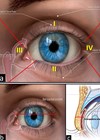Ophthalmology
Streamlining cataract lists: how are you managing it?
Mr Jonathan Ross, in conversation with Ms Bita Manzouri, provides a personal perspective on challenges and opportunities shaping the future of cataract surgery services across the hospital eye service. Redesigning cataract pathways in response to COVID-19 Bita Manzouri: Over the...
Periocular burns: a literature review of classification, management protocols and outcomes of treatment
The author provides a review of the current literature regarding the principles of classification, management protocols of acute ocular and periocular burns and the role of the burn and oculoplastic surgeon involved in their care. More than two-thirds of facial...
Headache: the clue is in the eyes
A worrying cause of headache is raised intracranial pressure (ICP). Papilloedema is a vital clue for accurate diagnosis and performing fundoscopy is essential in detecting this sign. The authors review the use of fundoscopy in their own district general hospital....
My top five Apps for UK-based general ophthalmologists
The way we interact in society is changing as more of us are becoming ‘digital natives’: individuals who are in close contact to the internet and expect to integrate smart devices with our daily lives. This was stereotypically a term...
DMEK vs. UT-DSAEK: has the debate been finally concluded?
In recent years the surgical treatment of corneal endothelial dystrophy has progressed tremendously. Descemet’s membrane endothelial keratoplasty (DMEK) is the newest iteration in the line of rapid surgical advances that has taken place. However, the previously accepted gold standard prior...
Thyroid eye disease
Thyroid eye disease (TED) is an autoimmune condition with a spectrum of signs and symptoms, usually associated with Graves’ hyperthyroidism. The diagnosis is based on history and physical examination but there are further investigations that can aid diagnosis if unclear....
Gene therapy for inherited retinal disease: the Manchester Ocular Gene Therapy Group MDT service
The authors describe the process set up in Manchester for the optimum delivery and assessment of a new gene therapy treatment for patients with RPE65 IRD. Inherited retinal dystrophies (IRDs) are the second commonest cause of severe visual impairment in...
Effective management of dry eye and ocular surface disease
Experts recommend a consistent approach to diagnosis, therapeutic targeting by disease subtype and escalation of therapy when tear substitutes are not sufficient. Experts call for a consistent, unified approach to diagnosis of dry eye disease (DED), with a new simple...
Sustainability in eyecare: Climate action in eyecare
Climate change will cause disruption to critical eyecare services and increases in rates of eye disease around the world. The International Agency for Prevention of Blindness has recommended 10 key areas of action on how the eyecare sector can address...
Sustainability in eyecare: Aravind Eye Hospital’s low carbon eyecare system
The field of healthcare has a substantial impact on the environment as it is responsible for 5-10% of greenhouse gas emissions and 9% of air pollutant generation [1]. Surgery is associated with the rapid consumption of single-use products and waste...
My top five Instagram accounts to keep your scrolling educational
There’s no denying that now, more than ever, we are better connected to our electronic devices; 24/7, around the clock. The phenomenon of ‘Zoom’ and ‘Microsoft Teams’ is shaping the future of medical education, national trainee recruitment and conference access....
Sustainability in eyecare: Intraocular gases and the climate emergency
In 2020 the NHS became the first national health system to commit to delivering ‘net zero’ carbon emissions by 2040. The author investigates how the impact of ophthalmic surgery can be reduced. Medical gases have been used in ophthalmic surgery...
















